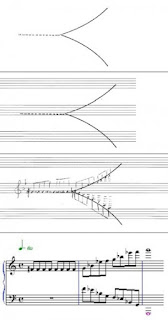In 2004 I struggled to define the mapping...while speaking in terms of
Kaluza/Klein and fifth dimension. Today I am fully aware of the mathematically representation in terms of the use of dimensions. At the time this was related to spirit. I was searching for how to describe where ideas came from?
This also forms the basis of my thoughts about geometry.
 |
| Betrayal of Images" by Rene Magritte. 1929 painting on which is written "This is not a Pipe" |
Betrayal of Images" by Rene Magritte
While a theoretical train of thinking is demonstrated below....subjectively dream information study and my own exploration help to form my thoughts.
Metacognition is defined as "cognition about cognition", or "knowing about knowing."[1] It can take many forms; it includes knowledge about when and how to use particular strategies for learning or for problem solving.[1]
Thus, primary consciousness refers to being mentally aware of things in the world in the present without any sense of past and future; it is composed of mental images bound to a time around the measurable present.[1]
By contrast, secondary consciousness depends on and includes such features as self-reflective awareness, abstract thinking, volition and metacognition.[1][2]
The AIM Model introduces a new hypothesis that primary consciousness is an important building block on which secondary consciousness is constructed.[1]
***
 |
| Partial map of the Internet based on the January 15, 2005 data found on opte.org. Each line is drawn between two nodes, representing two IP addresses. The length of the lines are indicative of the delay between those two nodes. This graph represents less than 30% of the Class C networks reachable by the data collection program in early 2005. Lines are color-coded according to their corresponding RFC 1918 allocation as follows |
Part of the exploration was to understand that we can build models for apprehension and this was my intent since lacking a teacher. I had to think about how knowledge could be held to being truthful within self. So I looked at my tendency with which to class information in an architectural way so as to house that information. As well to understand the meaning of mandalas and how these are housed in our makeup so as to reveal our previous attempts at soul full unification.
Was this tendency within my own self evident in others? Well ultimately recognizing indeed we each are different how is it you have concluded such a sate of mind as to the reason for believing what you do? So this is a conclusive statement for you and a connection to the way in which you will engage the world? Never mind that you will inherently try and describe what is intuitive to you so as to list the attempt at philosophically showing such "a location" as to being inductive/deductive so as to form what is self evident to you? The synapse?
Consider then you are an individual in your own court of justice? Judge and jury about the way in which you conduct yourself? Teacher and student as to the way in which you will acquire knowledge in life? Who will you look for so as to find these truths, but not to recognize as a soul that you will acquire these truths as a progress of your desire to be truthful? To evolve? How will you weight these things?
Historically then, I built a pyramid. The geometric proportions were to show how we can internalize and house information about ourselves. Early lessons were to understand that ancient minds were locked toward thinking about "lines of light and shadows" so as to direct this line to point toward other things?
Philosophically to me, "line of shadow and light" were in itself
demonstrative of this idea of a geometrical explanation to how we might
explain our first attempts at "components of that reality?" The sun had
to be a source of inspiration?
Is the sun a centralize thing in our own being so as to say that our expressive lives are now the objects of reality? Is this en tropically pleasing to you? So how do you touch that source?
How do you align yourself internally?
In that exploration, this was the ultimate realization.
Some may describe it as an epilepsy while sensing/feeling this electricity that runs through you? How powerful a motivator so as to describe that in each of us such an alignment can take place?






















